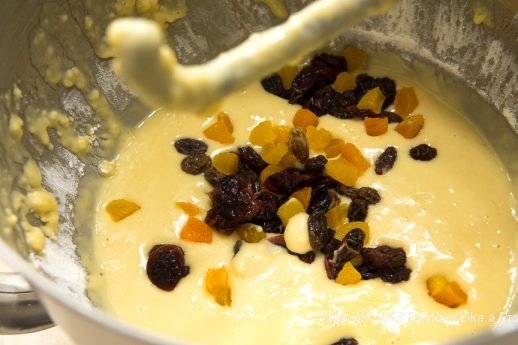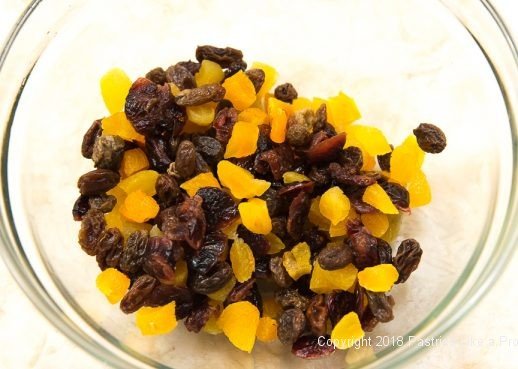
To make a long story short, I decided to use my mothers' sweet yeast dough which is the best I have ever encountered. It is soft, slightly sweet and tender. It is reminiscent of brioche. I added dried raisins, cranberries and apricots but you can use any combination of dried and/or candied rind you wish.
Since we are not coffee drinkers, I had no tall coffee can in which to bake this for the traditional tall, slender Kulich. I even stopped at my local gourmet kitchen store to see if they had one of the paper baking forms. But no luck. On my way out, I saw these adorable 2 and 5 ounce decorated paper baking cups that I fell in love with. The design doesn't change color in the heat of the oven. They are great for baking and giving as a gift and they look like Easter to me.
For the full-size Easter Bread, I used a very old (as you can see) Charlotte Mold. When we moved, I got rid of so much bakeware, but for some reason, I couldn't let this mold go. So happy I didn't. All of the dough would have fit in this 9 cup mold but I used some for the little ones.
To determine the amount of your baking dish or mold, measure the amount of water it will hold. A little under or over won't matter. You're going to want an 8 or 9 cup mold.
This Easter Bread is perfect for brunch or just a quiet cup of coffee or tea after everyone leaves.
It freezes well baked without the icing. I always prefer to thaw, then wrap in foil, leaving a small opening on top for the steam to escape and heat at 350°F for about 20 to 25 minutes to freshen it. Cool and then finish.
This Easter Bread is so easy and what I love the most about my mother's yeast dough is that it is so easy to work. While it seems rather sticky in the beginning, after rising, it is a dream to work with.
But don't just save this Easter Bread for Easter. It is perfect all year long.
My Easter Bread
¼ cup water
¾ cup milk
¼ cup sugar (50 grams or 1 ¾ ounces)
1 teaspoon salt
½ cup unsalted butter (1 sticks, 114 grams or 4 ounces)
3 eggs
½ teaspoon vanilla
Zest from ½ large lemon (about 2 teaspoons)
4 cups bread flour (550 grams or 19 ⅓ ounces)
1 ⅓ cups raisins, dried fruit or candied fruit*
*I used ⅓ cup raisins, ½ cup dried cranberries, ½ cup dried apricots.
If using dried fruit such as the raisins and cranberries, soak them in very hot water while making the dough.
Dissolve yeast in warm water. Set aside.
Heat milk, butter and sugar to simmering.; cool to lukewarm. 



Add half the fruit and beat well. 
Knead in bowl for 3 minutes.
When finished, remove from the bowl and hand knead several times until perfectly smooth.


Yield: Approximately 1200 grams or 2 ⅔.
To Bake
Cut a circle from parchment paper the size of the bottom of the dish or mold. Spray an 8 to 9 cup baking dish or mold well. Place the parchment paper on the bottom and spray it also. Shape the dough into a smooth round and place it in the prepared dish or pan, pressing it down to flatten it. It should come up to about ½ to a little more full.
For the small individual Easter Breads,
Cover with a towel and let rise for about 1 to ½ hours.
Preheat the oven to 350°F. Bake the large Easter read for 35 to 40 minutes until deeply browned. Cover the top loosely with foil if it browns too quickly. For the smaller Easter Breads, bake about 20 to 25 minutes. Cool.
To Finish
1 ½ cup powdered sugar (200 grams or 7 ounces)
¼ to ⅓ cup liquid of choice (milk, lemon juice, amaretto, brandy rum, etc.)
Mullti-colored nonpareils
Mix the two until completely smooth. Add additional powdered sugar or liquid as needed to make a thick glaze.
Pour over Easter Bread and use a small offset spatula to distribute to edges so it can drip down.














Christine Earles says
Quick question: Will the recipe make both the large loaf and smaller breads as shown, or one or the other? Thank you.
hfletcher says
Hi Christine - One recipe will make what is shown.
Christine Earles says
Thank you for the response-making bread tonight...
hfletcher says
Hi Christine - You are very welcome.
mybobba1Mari says
Looks wonderful, I saved to make after Passover
hfletcher says
Hi Marilyn - Good to hear - good to share.
Don says
Another great recipe and written expertly! Raisin and Crystallized Ginger dotted mine. Delicious!
hfletcher says
Hi Don - love your choices. Hope all is going well for you. Happy Easter
jim Richards says
Thanks for your clarification. My error. Love your recipes and commitment to the art of baking.
hfletcher says
Hi Jim, no problem and thanks for the kind words.
Mary E. Coyle says
Helen, I was reading this prior to making, and I don't see where you add the yeast dissolved in water that has been set aside. I can guess, but would prefer your original recipe. Thanks, Mary
hfletcher says
Thanks Mary for bringing this to my attention. It goes with the other liquids. I have corrected the recipe.
Elodia Cruz says
Thanks for this recipe, will try it this week end. Lately I have encounter problems with your web site if I want to print the recipe, it locks and gets a white glare over it.
hfletcher says
Hi Elodia, thanks for letting me know about the print option. I will check it out.
James W Richards says
Pashka is a molded cheese-not a bread like Kulich at all
hfletcher says
Hello James - I am referring to Paska, not Pashka. It is a bread that many countries claim including Ukraine, Poland, Slovak and is usually ornately decorated. If you google my spelling, not yours - Paska you will see many recipes for it.
Anita says
Interesting! I was so hoping to see this cut as I'm curious how similar (or not!) this is to Panettone bread, although this bread wouldn't have as light of a texture, I don't believe. It looks delicious. And, FYI, my 7 yr old grandson and I made your croissants (he is a croissants loving child - his first ever flight was at 13 months old when his mother and I took him to Europe. He was introduced to all the good things in life at a very young age. His favorite meal (-currently as this changes- this chickpea curry), and while the croissants were indeed an undertaking, they were amazing. He was in heaven. I believe comments are closed and I wasn't able to leave our thanks. There are other pastries on your blog I hope to tackle - I'm looking at you Kouign Amann - and I appreciate your blog and your excellent recipes and instructions.
hfletcher says
Dear Anita, thank you so much for this lovely note. Your grandson is certainly ahead of his peers with his palate. He is in for a delightful tasting life. I have a grandson who loves to bake also. He bakes for his gluten-free father also. It's is a joy to watch them grown, isn't it?